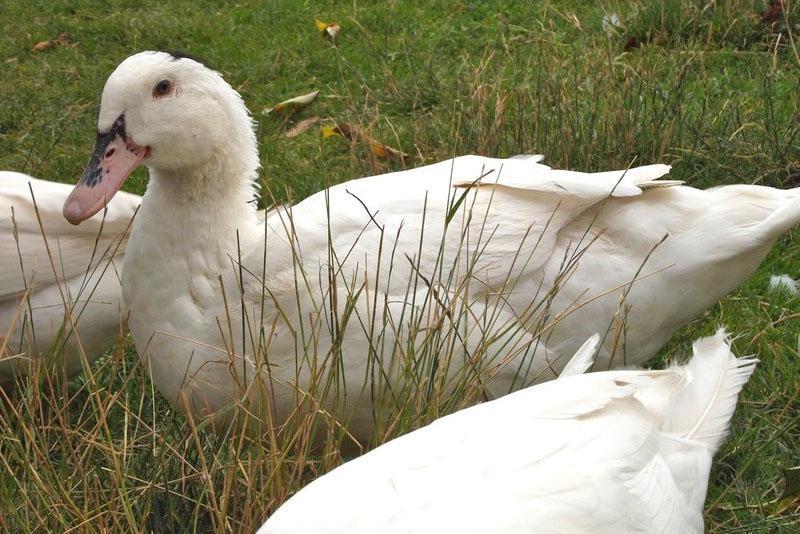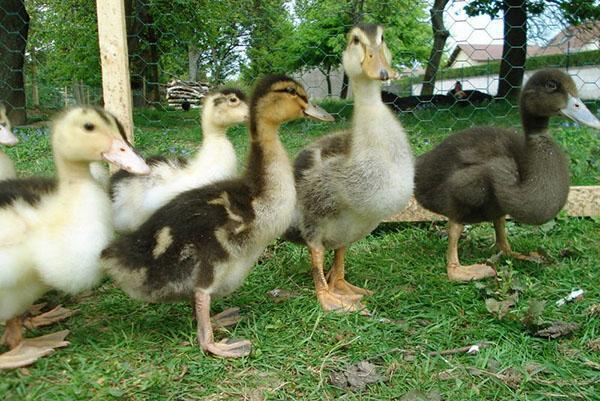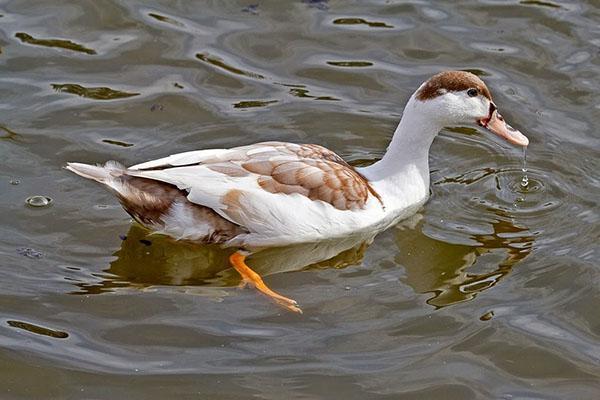Features of breeding mulard ducks at home
 Mularda ducks have earned the attention of large poultry farms and owners of private farms due to their rapid weight gain and excellent quality of gourmet liver. This variety of poultry has already supplanted geese, which were previously considered by gourmets the best "suppliers" of raw materials for foie gras, and are increasingly grown for meat in the households of ordinary amateur poultry breeders.
Mularda ducks have earned the attention of large poultry farms and owners of private farms due to their rapid weight gain and excellent quality of gourmet liver. This variety of poultry has already supplanted geese, which were previously considered by gourmets the best "suppliers" of raw materials for foie gras, and are increasingly grown for meat in the households of ordinary amateur poultry breeders.
However, among the breeds or species of domestic ducks, mulard cannot be found. The fact is that this is an interspecific hybrid, which saw the light only thanks to the inquisitive mind of man.
Read also the article:Indoor breeding maintenance home care!
The origin of domestic mulard ducks
The selection was based on representatives of muscovy ducks, which naturally inhabit the American continent, and common mallards of European and Asian origin. The ducklings obtained as a result of crossing were called mulard after two parts of the English names of the original species MUscovy duck and malLARD.

Although both females and males of mulard can show signs of sexual interest, they are completely sterile. Therefore, breeding mulard ducks at home does not provide for leaving the parent stock. All raised hybrid birds are slaughtered.
The offspring obtained from mating of musky and common, Peking ducks retain the positive qualities of both varieties and, importantly, reduce the influence of their weaknesses. For example, domestic ducks of meat breeds, although larger than their American relatives, quickly accumulate fat, which negatively affects the quality of products. At the same time, they do not differ in a calm disposition, are unscrupulous and do not always willingly hatch laid eggs. Muscovy ducks are not as early maturing as Peking or other meat breeds. On the other hand, they have amazing tender meat containing record low fat, are excellent hens, calm and vigilant about cleanliness.
 What mulard ducks will result from mating representatives of two different species? Most often, hybrid individuals have a variegated, black-and-white or white-brown color, but they are noticeably larger than their parents.
What mulard ducks will result from mating representatives of two different species? Most often, hybrid individuals have a variegated, black-and-white or white-brown color, but they are noticeably larger than their parents.
Features of breeding mulard ducks
To combine all the positive aspects and get strong offspring from interspecific pairs as early as possible, use male muscovy duck and common female mallard duck meat direction. As a result of natural mating, which is used to breed mulard ducks at home, ducklings from such pairs appear in the incubator after 30–31 days.
 For reproduction, sexually mature birds are chosen at the age of 7 to 10 months. The best period, when the percentage of fertilized eggs is highest, lasts mid-spring to early summer. By this time, the parent stock is formed from Peking and musk ducks. There should be 4–6 ducks per male in the pen.It is better if such a family has their own house with a walking area at their disposal. Population density is calculated on the basis of 1 meter of area for three birds inside the house and one meter per head for walking.
For reproduction, sexually mature birds are chosen at the age of 7 to 10 months. The best period, when the percentage of fertilized eggs is highest, lasts mid-spring to early summer. By this time, the parent stock is formed from Peking and musk ducks. There should be 4–6 ducks per male in the pen.It is better if such a family has their own house with a walking area at their disposal. Population density is calculated on the basis of 1 meter of area for three birds inside the house and one meter per head for walking.
Since the incubation instinct in beef breeds is insufficiently developed, laid eggs are removed. For further breeding of mulard ducks use incubator or put up to 20 eggs under a good hen, for example, a musk duck.
 Using this trick, experienced poultry farmers achieve a fairly high percentage of successful hatching. However, in this case, the duck will have to be taken care of separately. For the hen, it is very important not only to have drink and hearty feeding, but also to splash freely in the water. Damp feathers and warmth create the atmosphere necessary for the development of embryos. Therefore, in an incubator with laid duck eggs, irrigation with warm water is also used.
Using this trick, experienced poultry farmers achieve a fairly high percentage of successful hatching. However, in this case, the duck will have to be taken care of separately. For the hen, it is very important not only to have drink and hearty feeding, but also to splash freely in the water. Damp feathers and warmth create the atmosphere necessary for the development of embryos. Therefore, in an incubator with laid duck eggs, irrigation with warm water is also used.
Growing mulard ducks at home
Newborn ducklings are usually strong and unpretentious. Therefore, the further cultivation of mulard ducks has almost no special features. The main attention is paid to the selection of the diet for the fastest growth and weight gain.
 Often from poultry farmers one can hear the opinion that mulard ducks, in the photo, grow well on almost any feed. From the age of one month, chicks are released for walking and pay little attention to feeding the birds, hoping that live inquisitive ducklings will independently provide themselves with food. Such content, indeed, relieves the poultry farmer from many problems. But a bird left to itself will not be able to show the results that are inherent in it by nature. Although by the age of three months the chicks will grow larger than their parents, due to a lack of protein feed, an abundance of moisture, which contributes to the speedy removal of food from the intestines and serious energy expenditures per day, the mularda will not reveal the full potential of the mularda.
Often from poultry farmers one can hear the opinion that mulard ducks, in the photo, grow well on almost any feed. From the age of one month, chicks are released for walking and pay little attention to feeding the birds, hoping that live inquisitive ducklings will independently provide themselves with food. Such content, indeed, relieves the poultry farmer from many problems. But a bird left to itself will not be able to show the results that are inherent in it by nature. Although by the age of three months the chicks will grow larger than their parents, due to a lack of protein feed, an abundance of moisture, which contributes to the speedy removal of food from the intestines and serious energy expenditures per day, the mularda will not reveal the full potential of the mularda.
From the first weeks of life, chicks should have a balanced diet with a predominance of specialized feeds or nutritional mixtures based on grain.
 The competent organization of feeding mulard ducks and their maintenance determines how much weight the bird will gain by 7-9 weeks and later, when the time for slaughter comes. For fast fattening of ducks, they try to restrict movement. Due to the ability to grow lean meat with a low fat content, inherited from their musky ancestors, domestic mularda ducks do not get fat even on a hearty diet and without long walks. Therefore, free range is not provided for them, and feeders and drinkers are installed in the immediate vicinity of the herd location.
The competent organization of feeding mulard ducks and their maintenance determines how much weight the bird will gain by 7-9 weeks and later, when the time for slaughter comes. For fast fattening of ducks, they try to restrict movement. Due to the ability to grow lean meat with a low fat content, inherited from their musky ancestors, domestic mularda ducks do not get fat even on a hearty diet and without long walks. Therefore, free range is not provided for them, and feeders and drinkers are installed in the immediate vicinity of the herd location.
Raising mulard ducks is akin to keeping broiler chickens, when everything is aimed at a quick increase in carcass weight.
Juicy food and herbs are added to the mash or given separately. Water is offered in drip troughs. When feeding mulard ducks, the tendency to pecking is also taken into account, therefore sulfur and feed rich in calcium must be introduced into the diet. We must not forget about such important components of the menu as fish and meat and bone meal, yeast and mineral supplements. Ducklings should receive them from the first month of life.
 Under industrial conditions, mulards go to slaughter at the age of 7-10 weeks. Ducks produce excellent meat, and today males are increasingly fattened to obtain the most delicate raw materials for foie gras.
Under industrial conditions, mulards go to slaughter at the age of 7-10 weeks. Ducks produce excellent meat, and today males are increasingly fattened to obtain the most delicate raw materials for foie gras.
When using forced feeding of mulard ducks by the age of 4 months, poultry farmers manage to obtain a 500-gram liver of the highest quality. By the same time, the weight of the bird itself can reach 4 or more kilograms.
A video about caring for mulard ducks will be a useful help for a novice poultry breeder. Subject to the rules of keeping, proper feeding and maintaining cleanliness in the poultry houses, this unpretentious, interesting bird will delight you with rapid growth and excellent quality of meat products.